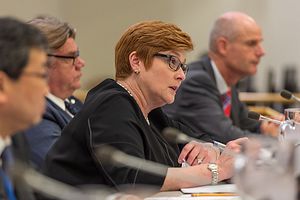Australia continues to demonstrate that its “Pacific step-up” is not mere rhetoric. After the prime minister’s official visits to Vanuatu and Fiji in mid-January, the Chief of the Defense Force quickly followed with trips to Vanuatu, Tonga, Fiji, and Solomon Islands for discussions with his regional counterparts, and now this week Foreign Minister Marise Payne has also visited the Solomon Islands, before moving on to Tuvalu.
The main purposes of Payne’s visit to the Solomon Islands was to inaugurate the $144 million Coral Sea Cable System with the Solomon Islands’ caretaker Prime Minister Rick Houenipwela (Solomon Islands are in election period therefore the government is in caretaker mode). The submarine fiber optic cable will link Sydney to Honiara in Solomon Islands, as well as to Port Moresby in Papua New Guinea. Australia will also aid in the construction of a Solomon Islands domestic broadband network, which Houenipwela has described as “game-changing infrastructure.” Presently, the country is wholly reliant on expensive satellite technology to access the internet. The project is set to be completed by December.
The undersea cable project is seen as one of Canberra’s more significant displays of regional commitment, albeit one that is not entirely altruistic. The Australian government’s decision to implement the project (it will provide to-thirds of the costs) came after Australia’s security agencies warned of the risks associated with allowing Chinese firm Huawei to provide a fiber optic cable to the Solomon Islands. The risk assessment lay both in the connection of the cable to telecommunications infrastructure in Sydney, and also in terms of the threat that it posed to Australia’s regional hegemony.
Due to the geographic isolation of the Pacific Island states, with their small populations often dispersed over numerous islands and vast swaths of ocean, the delivery of essential services can be difficult and expensive for their governments to provide. This makes any outside assistance welcomed by Pacific leaders. However, for Australia, a core component of its strategic doctrine is to prevent any unaligned powers from gaining significant influence in the South Pacific. Until recently no unaligned power had done so since the conclusion of World War II, which seems to have bred a complacency that Canberra is now in the process of rectifying in the face of Chinese regional competition.
Key to Australia’s Pacific step-up is a recognition of the infrastructure deficit that exists in the Pacific and a serious commitment to work with Pacific leaders to do something about it. Payne noted in a speech to the Lowy Institute in November that the Pacific region will require $3.1 billion in infrastructure investment each year until 2030, adding that Australia has signed a trilateral memorandum of understanding with the United States and Japan, to encourage more private capital into the region to help address these infrastructure deficits.
Australia’s 2016 Defense White Paper stated that it will “continue to seek to be the principal security partner for Papua New Guinea, Timor-Leste and Pacific Island countries.” However, this understanding of security should not just be one of dissuading other other powers from the region, , but also coincide with the expanding of Australia’s aid program objectives to creating positive health and educational outcomes, as well as promoting economic growth and a reduction in poverty. In this regard the Coral Sea Cable System is a positive step towards this aim. Recent research conducted by the World Bank estimates that access to highly quality internet connectivity in the Pacific region has the potential to create an additional $5 billion in economic activity and create an additional 300,000 jobs by 2040.
For the Coral Sea Cable System to hope to achieve and then further expand on these outcomes, it will need to coordinate with the next major project on Canberra’s development radar; the Papua New Guinea Electrification Partnership. At present only 13 percent of PNG’s population of 8.2 million is connected to the country’s electricity grid, limiting the transformative potential of the Coral Sea Cable System when it is connected to Port Moresby. The partnership signed by PNG, Australia, New Zealand, Japan and the United States at the APEC summit in November seeks to boost that percentage to 70 percent by 2030.
The recent Chinese activity in the region has pushed Australia into complementing its conventional development assistance programs with these big ticket items that demonstrate a more conspicuous presence. Ultimately this competition will be positive for the region as long as projects like the Coral Sea Cable System are delivered with both quality and local agency in mind, and Australia’s geostrategic aims come naturally as a consequence of increased Pacific Island capabilities.

































